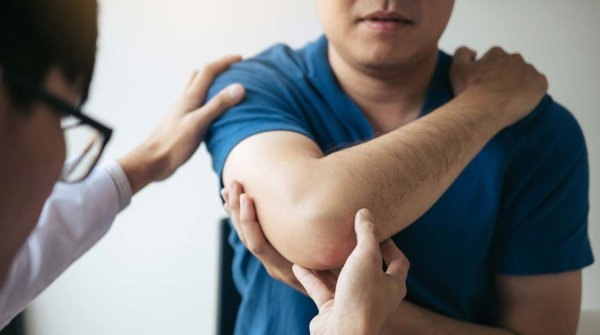
Strained muscles, joint pain, vertebral blockages: Anyone who regularly plays sports and trains their fitness is not immune to injuries. Once not warmed up properly or been unfocused during the exercises, it has already happened. After the damage has first been examined by an orthopaedist, in many cases the path leads to a physiotherapist. Depending on the type of injury, the physiotherapist uses physiotherapy, manual therapy or massages to get the damaged musculoskeletal system back into shape. But what are the classic sports injuries and what does the treatment look like in detail?
A dreaded classic among sports injuries is meniscus damage. The menisci are two ring-shaped cartilages in the knee joint and are divided into outer and inner meniscus. They serve as a kind of shock absorber and buffer force impacts between the upper and lower leg bones. Particularly in running sports with jerky changes of direction, such as football, volleyball or handball, but also in twisting falls, as often occur in winter sports, cartilage damage can occur.
After a concrete diagnosis has been made by X-ray or magnetic resonance imaging (MRI), depending on the type of injury, the patient either goes to the operating table or straight to the hands of the physiotherapist. In the so-called conservative therapy, the physiotherapist first tries to calm the irritated and often inflamed tissue around the menisci. Lymph drainage and mobilisation techniques are usually used here. Once the inflammation has subsided and the knee can be moved again without pain, strength training, muscle building and stabilisation exercises help to make the knee fully operational again.

In each knee there is one anterior and one posterior cruciate ligament. Their task is to stabilize the tibia and femur. In contrast to damage to the menisci, which can often be treated with conservative therapy, surgery is usually the only option for a complete cruciate ligament tear. Here, too, the MRI or X-ray initially provides information about the type of injury.
If there is only a cruciate ligament tear, the physiotherapist can first try to relieve the swelling with the help of cold therapy. This involves the use of ice casts or cold baths. Once the swelling has gone down, mobilisation as well as muscle building and strength training are also on the programme in order to restore the stability of the knee.
In the case of a complete cruciate ligament tear, surgery is usually performed as soon as the swelling has subsided somewhat. The patient's health, age and activity level also play a decisive role here. A young athlete is much more likely to be advised to undergo surgery, as the permanent instability can not only lead to a loss of performance during training, but also to early arthrosis. After the operation, mobilisation exercises, muscle building and strength training are used to try to restore the initial level.
The ankle joint in particular is extremely susceptible to torn ligaments. The cause of a ruptured ligament is often the severe twisting of a foot, in which the ligaments are overstretched and, in the worst case, tear. Especially in jumping sports such as volleyball, basketball or gymnastics, the risk of twisting an ankle during an uncontrolled landing is high.
Typical for a torn ligament is a fast onset, severe pain in combination with a strong swelling. Before the physiotherapist can initiate further measures and begin mobilisation, it is therefore first important to reduce the swelling. The so-called PECH rule applies here: rest, ice, compression, elevation). As long as passive structures such as bone or cartilage remain uninjured, surgery is not necessary in most cases. Once the foot can be moved again without pain, physiotherapy in the form of mobilisation and strength training is started. In addition, it is recommended to wear a medical support splint for a certain period of time to prevent a renewed twisting of the ankle.
The occurrence of a muscle fiber tear depends very much on the type of sport practiced. For example, while quadriceps and calf muscles are often affected in running sports, torn fibres often occur in the biceps and chest muscles in fitness and strength training. As an immediate measure, it is recommended to cool the affected area - this can reduce swelling and bruising. Although a torn muscle fibre heals on its own in most cases, various physical therapy measures can speed up the recovery process. Exercises that reduce muscle tension, lymphatic drainage, and stimulation current therapy are particularly useful for this purpose.
So keep in mind. You do not have to go to the operating table immediately for every sports injury. Physiotherapy can often help.
- Awards
- Mountain sports
- Bike
- Fitness
- Health
- ISPO Munich
- Running
- Brands
- Sustainability
- Olympia
- OutDoor
- Promotion
- Sports Business
- Textrends
- Triathlon
- Water sports
- Winter sports
- eSports
- SportsTech
- OutDoor by ISPO
- Heroes
- Transformation
- Sport Fashion
- Urban Culture
- Challenges of a CEO
- Trade fairs
- Sports
- Find the Balance
- Product reviews
- Newsletter Exclusive Area
- Magazine






